On Capsizing and Recovery
Yacht designer Richard Woods' talk about this important subject
Designer Richard Woods kindly offered to share the informative transcript of a presentation he gave on capsizing and the associated conequences. We have included the videos he references. Enjoy! —Eds
This is the transcript of the Capsize Recovery talk I gave at the 2016 Port Townsend Wooden Boat Festival. Please note, the Youtube videos provided were edited in the talk. Also some photos were copied from websites. I acknowledge any copyright and if you feel infringed I will remove them. —Richard Woods
I'll start by explaining who I am. You can already tell that I'm not from around here, even though I have spent the last 11 summers in the PNW.
Our current cruising boat is the Skoota 28 powercat, which we have shown at the festival for the last couple of years. Here you see it in the Harmony Islands of British Columbia.
After last year's festival we had the boat trucked to Texas, and from there we cruised east to Florida and the Bahamas, where we spent the winter. As a result we have now circumnavigated the USA, in the sense that we have anchored in every coastal state and been to all 4 corners. We go back to the Bahamas again in November.
While we were there I taught dinghy sailing and raced a Sunfish, a Freedom 46 and, more dramatically, I also raced on the Abaco Rage, a Class A Bahamian sloop.
It is not an optical illusion. The boat is only 28ft long, yet it has a 34ft boom and a 60ft unstayed mast. It also has 3 sliding seats and races with 16 crew.
I have done both R2Ak’s, although I did not finish either. This is me steering through Seymour Narrows last year on Nice Pair.
While this is the 14ft Zest dinghy we built here during last years 2 day Edensaw challenge. I'm sailing it Sunday lunch time. It was just sheets of plywood on Friday morning.
I'm not going to explain any complicated theory like this, for this is a practical talk on stability. Even so, I do need to outline some basic concepts. So first what is a boat?
This is the Guillemot seen in the Small Boats Monthly heading sequence of Wooden Boat magazine website and forum. It's a scary photo of a dangerous boat. No buoyancy at all, the crew doesn't appear to be wearing a lifejacket. "Ah!" you say, "it won't capsize so what are you worrying about?" Well look at the top mainsheet block, see the sheet lead? No swivel! So what are the chances of it running out freely in a sudden gust?
Then this photo is from last week’s accident in San Francisco Bay. A Sea Scout boat capsized and 18 people were rescued. Look at how its floating! Again, no buoyancy at all!
And that is why I am giving this talk and why we’re doing these practical demos. One of the practical tests I've done myself is to take a USCG approved boat and swamp it to see what really happens.
As you can see, even without the engine or any equipment it is awash. I wasn't able to safely get on board even in a dry suit. This level of flotation is illegal in Europe. There we believe a boat must support the weight of the crew; there is no point in getting just the boat back if the crew drown. Only the insurance company benefits. Next, another obvious slide - boats heel by the wind.
And that heeling is balanced by two factors.
First is what we call form stability. Which is basically the shape of the boat. A wider boat is more stable. Until recently all boats throughout history have relied just on form stability. Powerboats, dinghies and multihulls still do. And then there is the modern sailing monohull with an external ballast keel.
What makes the keelboat unique when compared to all other boats is that, in theory, it should self right after capsizing. Unless it sinks first.
And that would be due to what we call downflooding, or the downflooding angle. Basically the angle of heel at which water starts to enter the boat. If it doesn't have a self draining cockpit or buoyancy then it can sink before it self rights. And that downflooding angle can be quite low, in the 30-40deg range, even if the capsize angle is much higher
And this is a Falmouth working boat, which can be "sailed under" and thus sink, despite high stability
The major factor that determines whether a boat will self right or not is the position of the centre of gravity. The lower it is the more stable. Typically on an unballasted boat it will be near the gunwale, and near the waterline if it is ballasted. The rig weight makes a huge difference, the lighter the mast the lower the centre of gravity and thus the safer the boat is. And that is especially true on an open unballasted boat.
OK that’s the basics. In a minute I'll talk about crew rightable boats. But first: Check this out
Now here’s another slide, to emphasize the point.
That’s why it’s vital to get a boat upright again and you back on board as soon as you can.
This is the ideal, so if your boat doesn't have all these attributes consider changing something.
How do I know how stable my small boat is? Well, the first thing to do is a trial capsize in safe test conditions with someone around to help if things go wrong.
This is my 10ft Duo dinghy, I'm testing it in rowing mode although it can also be sailed. It has buoyancy bags on the outside, where they do the most good and free up space inside. Making it a bit like a rib in fact. The bags act as big fenders when coming alongside and also work as beach rollers. We have now changed them to tapered full length ones, a bit like those used on the Walker Bay dinghies. A lot neater, but they were 10 times the price.
Still in controlled conditions, and with a rescue boat in attendance, here is the PT 11 dinghy being capsized and then righted. Very little water comes on board. What remains in the cockpit is there in part because, like the Duo dinghy I just showed you, it is a nesting dinghy so it cannot have a big aft buoyancy tank. However it is easy to bail out and then reboard.
You might think that a little bilge water doesn't affect stability, but it fact it is really bad. I'm sorry it’s hard to explain without some math, so just accept it.
It is much better is to have a self draining cockpit or one with more buoyancy, as in this next video which shows one of Graham Byrne's 10-footers. With extra buoyancy it doesn't need bailing out
So far I've shown you small boats, 10-ft long and under 100 pounds that are easy for a man to right by brute force. But bigger heavier boats or lighter crews need to use a different technique.
And that is by the use of righting lines. Here you can see the crew pulling it out ready to use, normally it is clipped under the outer gunwale out of the way. Again try it first in controlled conditions. If you have no righting lines fitted you can the jib sheet, I have also used the painter.
So, a bigger boat and a young girl doing the work. It is actually a two-person boat, right now the man is throwing the girl the jib sheet which she is going to use as a righting line. You can see that once she gets it she literally walks up the side of the boat and it comes upright. The man stays on the lee gunwale and gets scooped on board as it comes upright. He is then able to help the girl get back on board while the boat is more stable with his weight already in the boat. Knots in the line help, one reason why proper righting lines are far better than using a jib sheet. Also if it is windy you don't really want the jib sheeted in as you right the boat. It will probably capsize again and certainly start sailing off before you are ready.
If there is too much buoyancy you will have problems righting the boat. For starters, the boat floats very high, so can drift away downwind quickly and can easily invert, see one girl is holding the mast up to stop that happening. It will be hard to reach the board to begin to right it, while you can see how hard it is without a righting line. Although they got the boat back up unaided I don't think they could do it in a real capsize.
The Optimist is one of many older designs that relies on buoyancy bags. If they are not properly fixed down they will float up and thus not be effective. This young helm can right his boat easily, but the boat comes up swamped. That is because his buoyancy bags are not held down firmly but float up rather than supporting the boat. This is something you should check during your practise capsize. It is also a great test for your daggerboard, now is not the time for it to break!
So here's the first real capsize video, on a 16-foot boat. Upside down and with spinnaker hoisted, the worst combination possible. But at least they have righting lines.
The helm should have been prepared to get wet!! They would have righted the boat much quicker with two pulling on the righting line. The righting line is clipped along the underside of the gunwales and fastened at the main shroud. It is important to get the spinnaker down first, otherwise it will fill with water and cause huge drag.
These next two videos may be extreme cases but do show a couple of points.
The first is that you must always stay as close to your boat as you can, if it is windy and has high freeboard when on its side then it may well blow away faster than you can swim
I like the RS400 and have often sailed them, the last time was at this club, fortunately not in this much wind, even so we did capsize—and it was snowing at the time.
The best way to right a boat in these extreme conditions is to have one crew holding the boat head to wind. This ensures the boat stays head to wind when it comes up and so won't blow over again
For obvious reasons, this is not a very clear video. It is a 16-foot Wayfarer, used by many sailing schools in the UK. It is also a sistership to the one Frank Dye sailed from the UK to Norway and to Iceland. The two reasons the boat needs rescuing are, first the crew let the centreboard drop down into the slot when the boat rolled over and second, the aft buoyancy tank hatch came loose. Both often happen and are major design faults with the Wayfarer. Ok now you have the boat upright and you are back on board. But you are still not safe, as the boat may be full of water
Obviously a boat with an open transom will drain fastest and also make boarding much easier. With a closed transom you can fit transom flaps as shown here
See how fast the water comes out of this 14-foot dinghy fitted with transom flaps and without anyone bailing.
So far I have only talked about sailing dinghies. But bigger open boats can also capsize.
Here is a 23ft replica of the boat used by William Blyth for his 4000 mile open boat sail after the Mutiny of the Bounty. We performed a capsize/recovery test in the UK before it was sent out to the S Pacific. You can watch the documentary by going to Channel 4 and searching for "Mutiny". As you can see it’s very similar to the long boats used here. Which, by the way, are also capsized every year for their coastguard certification
You will have seen traditional ships lifeboats with rope loops on the gunwales. We realised that those are not just to hang onto when the boat is upright. They also make great foot straps when the boat is capsized. For we had to balance on the narrow gunwale, which would have been really difficult in a real incident. One addition we were also going to make was to add a permanent grab rope along the keel to use as a righting line.
You can see me in the yellow hat. We used 4 people on our first test, but later did it again with three and still righted it. Not surprisingly it came up very full of water, which took 20 minutes to pump out using 2 built in electric pumps. Which was far too long.
Now we are going to demonstrate some of this for real. When you leave here you should also practise capsize recovery yourself. Basically because, if not, why not? I can go out tomorrow and capsize any boat here. If I can, then so can you. Get prepared while people are around to help—don't wait until you or your family are out alone in bad weather. ###
Which we did and you can see the video here:
Author’s note: In the discussion we debriefed the crew about their experiences and also discussed suitable clothing for small boat sailing, getting back on board and other topics. We carried on past our allotted time but eventually were told the room was needed for the next event.
The Port Townsend WBF organisers were very pleased with the demos and promise to run them again, hopefully in an area where more people can view the capsize. •SCA•
For more information on Richard Woods, his designs, and to read many useful articles, visit his website here.




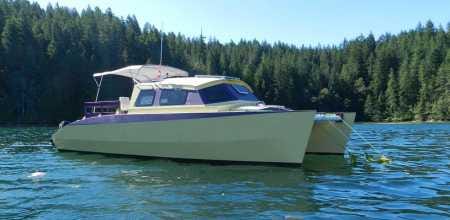

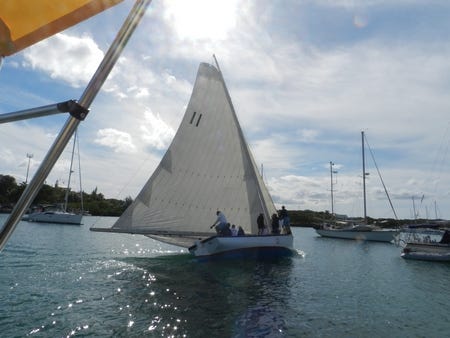


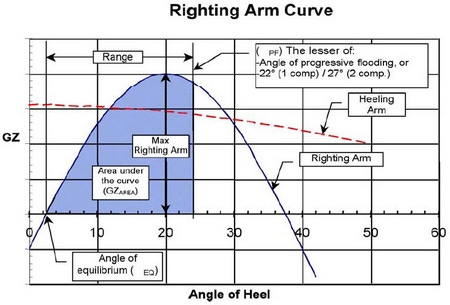
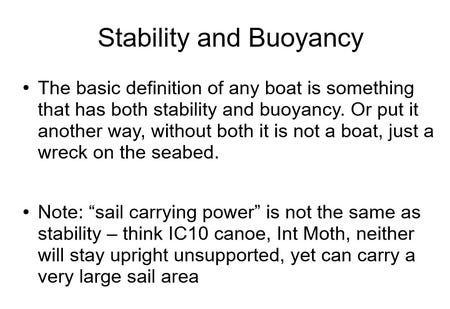

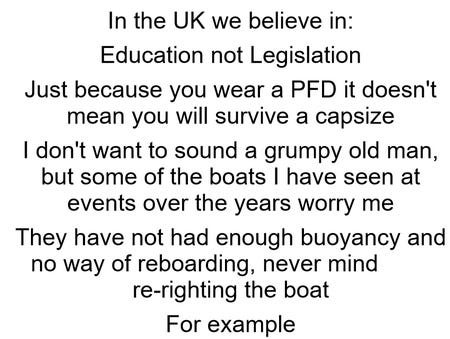

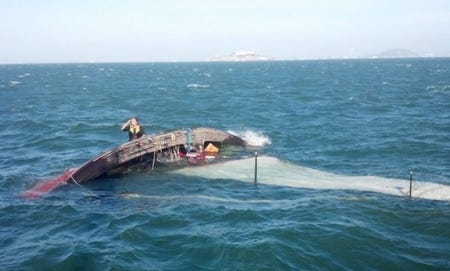
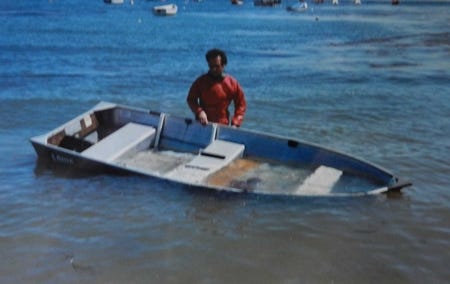
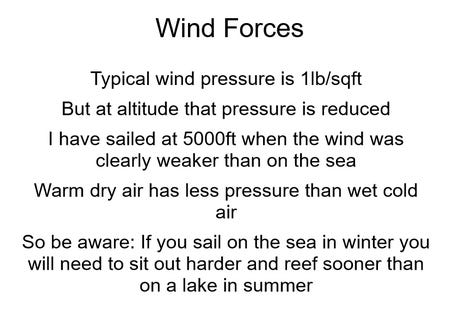
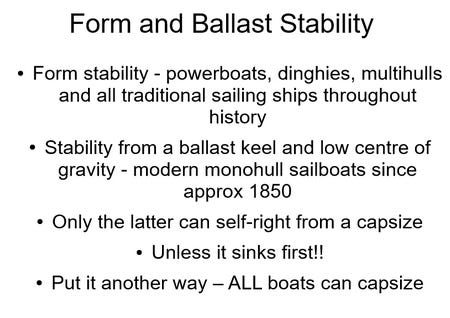
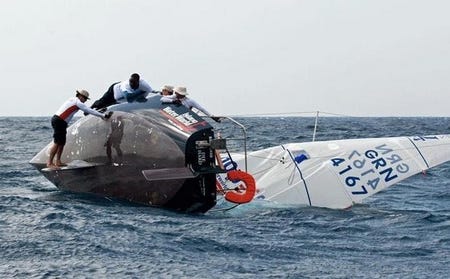

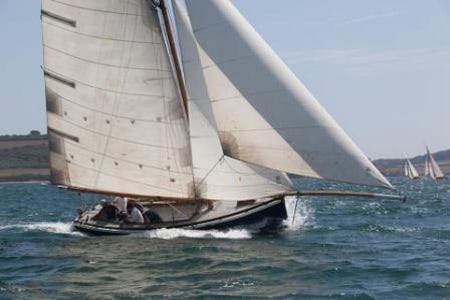
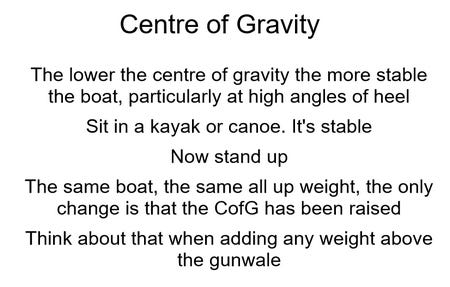
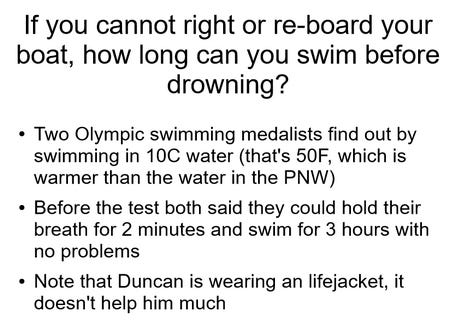

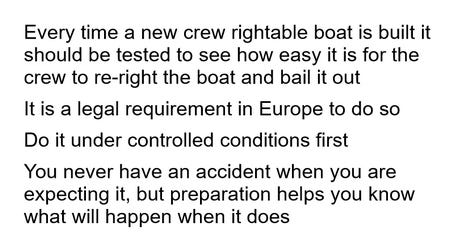


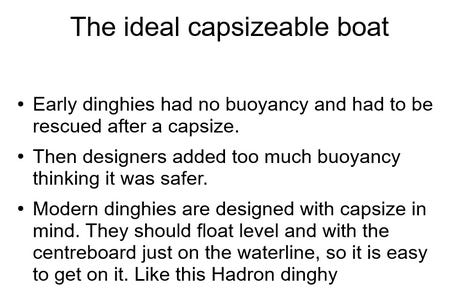
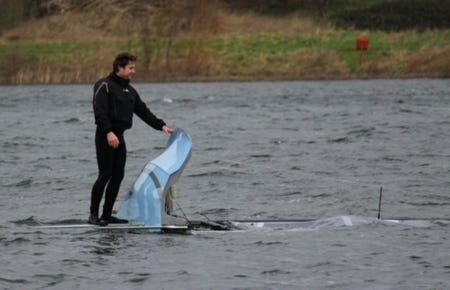
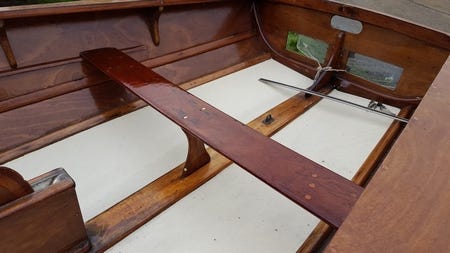
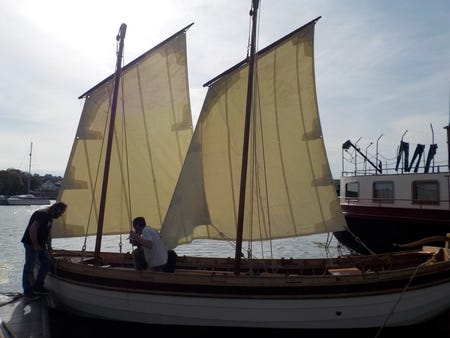

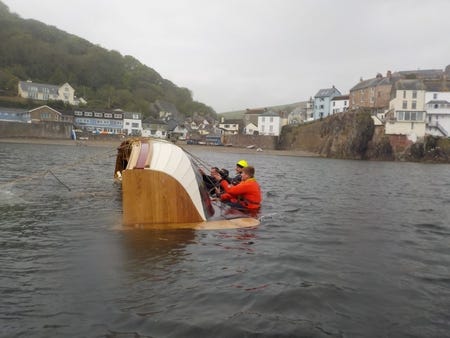
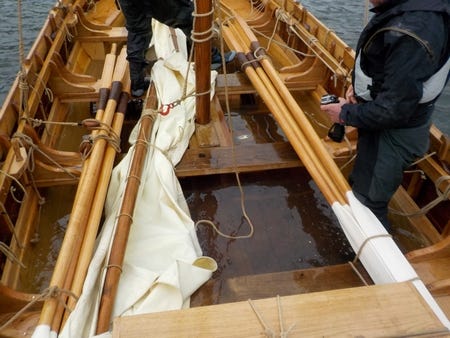
Thanks Richard. A point you make, that I would like to reinforce, it is easy to practice in calm water, but when it’s blowing 20+, with 2-3’ waves, things get far more difficult, just as the mast comes up, the wind catches it and blow it over onto you, and waves come over the rail, filling the boat you’re trying to bail. You get cold and tired. Getting back into the boat gets more difficult. Thinking ahead and having a plan to assist with each of these can change a life threatening situation into a simple self rescue.
Many excellent points, and I really appreciated the supporting materials as well. I don't think explaining Free Surface Effect basics requires math, though.
Imagine everything heavy in your boat is in a barrel that's free to roll sideways across the deck or bottom. If you've been on a sailboat with crew serving as moving ballast on the high / windward side, picture them on roller skates. Every time the boat heels, the barrel or skaters roll to the low side, tending to immerse the rail and/or capsize the boat. You can use obstacles to lessen the effect by splitting them up and keeping them from rolling as far. Water responds to gravity (and baffles) much the same way.